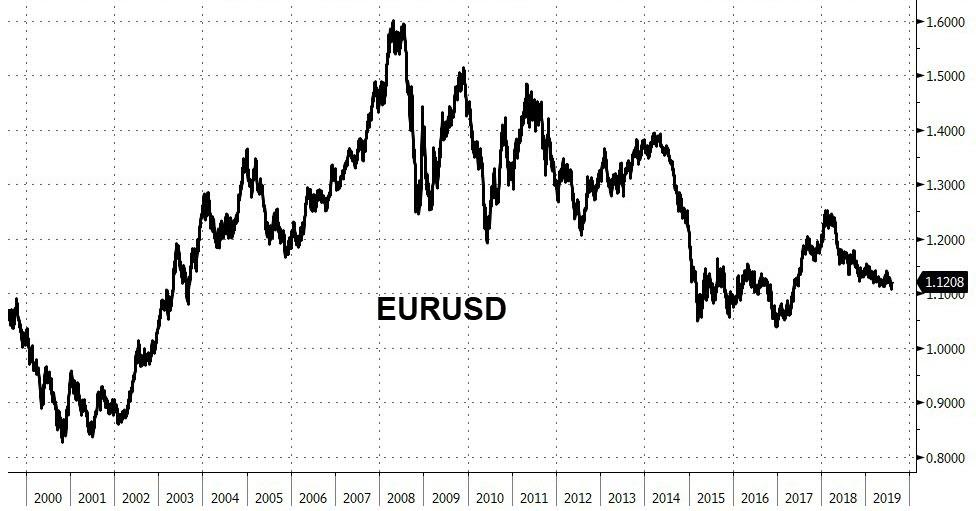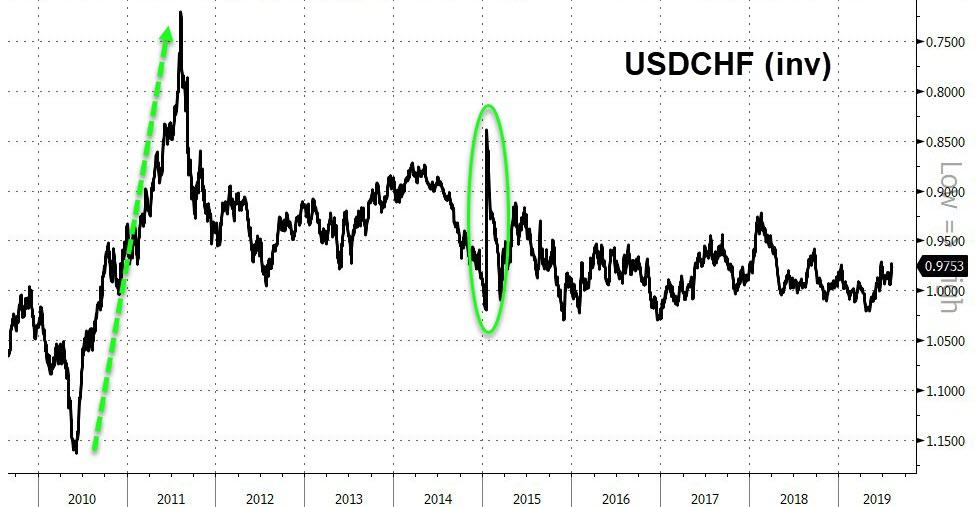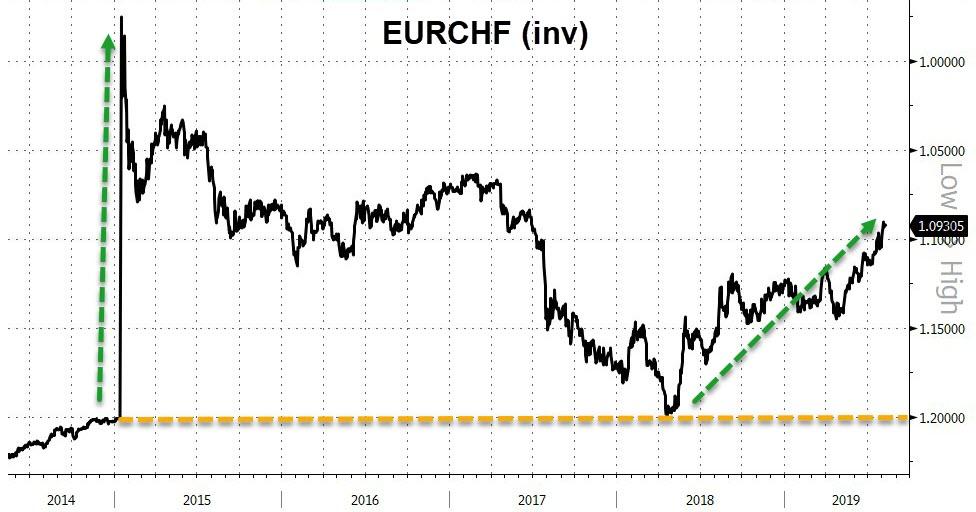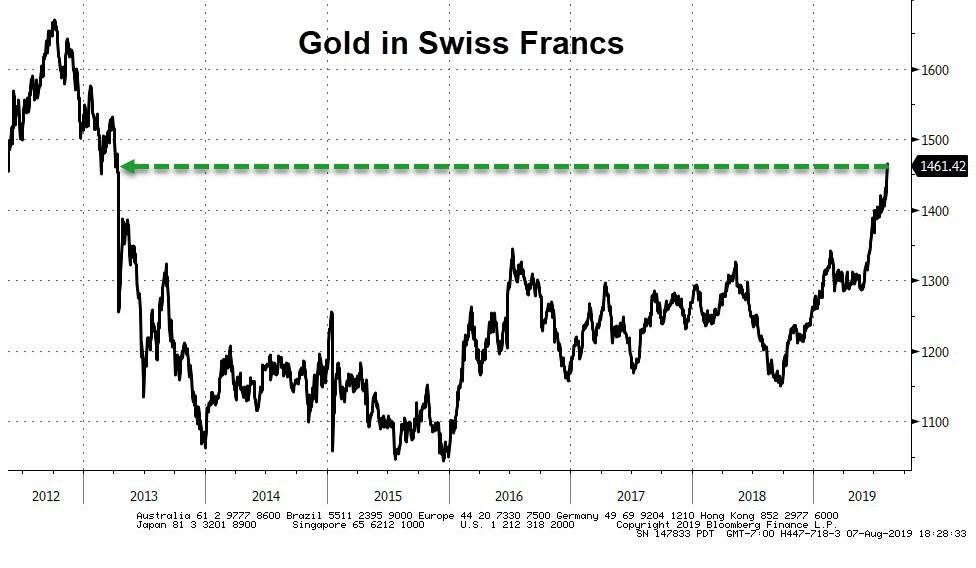https://www.zerohedge.com/news/2019-08-07/swiss-battle-cheapen-franc
The Swiss Battle To Cheapen The Franc
One of the crucial insights in currency trading that many investors fail to grasp is that currencies don’t go to zero, and they don’t go through the roof. That’s a generalization, but an important one. Here are the qualifications:
This observation applies to major currencies only — not to currencies of corrupt or incompetent countries like Venezuela or Zimbabwe. Those currencies do go to zero through hyperinflation.The observation also applies only in the short-to-intermediate run. In the long run, all fiat currencies also go to zero.
Yet over a multiyear horizon, major currencies such as the dollar (USD), euro (EUR), yen (JPY), sterling (GBP) and the Swiss franc (CHF) retain value and do not go to extremes. Instead, they trade in ranges against each other. That’s the key to successful foreign exchange trading. Trading profits are the result of catching the turning points.
Stocks can go to zero when a company goes bankrupt. Enron, WorldCom and a host of dot-com stocks in the early 2000s are all good examples. Bonds can go to zero when a borrower defaults. That happened to Lehman Bros. and Bear Stearns.
But major currencies do not go to zero. They move back and forth against each other like two kids on a seesaw moving up and down and not going anywhere in relation to the seesaw.
The EUR/USD cross-rate is a good example. In the past 20 years, the value of the euro has been as low as $0.80 and as high as $1.60. There have been seven separate instances of moves of 20% or more in EUR/USD in that time period. But EUR/USD never goes to zero or to $100. The exchange rate stays in the range.
Turning points in foreign exchange rates are driven by a combination of central bank interventions, interest rate policies and capital flows. The old theories about “purchasing power parity” and trade deficits are obsolete.
Foreign exchange trading today is all about capital flows driven by policy intervention, sentiment and interest rate differentials.
Another good example is the Swiss franc (CHF). If you look at its exchange rate with the dollar, an exchange rate of 0.80 francs per dollar indicates a strong franc. An exchange rate of 1.05 francs per dollar indicates a weak franc. Right now the exchange rate is 0.97, which leans towards a weak franc relative to the dollar.
CHF has traded in a range of 0.87–1.03 for the past six years. One move that stands out is the spike on Jan. 15, 2015, when CHF surged from 1.02 to 0.86, a nearly 20% move in a matter of hours. CHF then backed off that high of 0.86 and declined to its more recent trading range of 0.91–1.03.
The spike on Jan. 15, 2015, was caused entirely by the decision of the Swiss National Bank (SNB) to remove a cap on the Swiss franc relative to the euro intended to protect Swiss exports.
The Swiss economy is heavily dependent on exports of precision equipment, luxury goods such as Swiss watches and food including cheeses and chocolates. The Swiss economy also depends on tourism, which is akin to a service export sold to foreigners. All of these exports suffer when the Swiss franc is too strong.
The SNB has been enforcing the cap by printing francs and buying euros to put downward pressure on the franc. The problem with this policy is that the world wants francs as a safe haven.
That was especially true during the European sovereign debt crisis of 2010–2015. The SNB balance sheet was becoming top-heavy with European debt purchased with printed francs at a time when the European debt itself was in distress.
Eventually, SNB threw in the towel and allowed market forces to determine the value of CHF. This produced an immediate spike in CHF against the euro and the dollar, which has since moderated into a trading range.
But the franc is currently at the 1.09 level versus the euro, on expectations of monetary easing in both the euro zone and the United States have set in.
So the SNB has been buying euros in an attempt to get out ahead of the curve. It’s trying to cheapen the franc to keep its exports and tourism industry competitive. You see evidence for this in its so-called sight accounts. Sight account can be transferred to another account or converted into cash without restriction.
There has been a recent surge in these accounts lately, which indicates the SNB has been actively intervening in the currency markets.
With rising market uncertainty and hot money in search of safe havens, what does the future hold for the Swiss franc?
The single most important factor in the analysis is that hot-money safe-harbor inflows are clashing with the SNB’s cheaper franc policy.
The demand for Swiss francs will be driven by the lack of palatable alternatives. Investors are increasingly concerned about sterling because of conditions imposed by the EU, Ireland and others in the Brexit process. Brexit is irreversible, but satisfying all of the demands of interested parties to achieve Brexit will weaken the U.K. economy and sterling.
Likewise, the dollar and yen are both the cause of investor concern because of out-of-control debts. The Japanese debt-to-GDP ratio is over 250% and the U.S. debt-to-GDP ratio will soon be 110%. Any ratio higher than 90% is considered a danger zone by economists.
Almost all Japanese government debt is owned by the Japanese people, so there’s a higher threshold for panic in Japan than in the U.S. The U.S. debt is about 17% owned by foreign investors who could choose to dump it at any moment. Still, both Japan and the U.S. are on unsustainable paths and have shown no willingness to tackle their debt problems or reduce their debt-to-GDP ratios.
The euro offers better debt-to-GDP ratios than Japan or the U.S. in the aggregate. However, the European Central Bank is getting ready to pursue more quantitative easing and near-negative interest rate policies. The euro is also plagued by lingering doubts about the individual debt situations in Greece and Italy, a legacy of the 2010–2015 European debt crisis.
Meanwhile, the Swiss debt-to-GDP ratio is about 30%. In fact, Keynesians complain that its debt levels are far too low!
Russian rubles and Chinese yuan are unattractive for major global capital allocators because their markets lack liquidity and they do not have satisfactory rule-of-law regimes behind their currencies.
With dollars, yen, sterling, the euro and emerging-market currencies all unattractive for different reasons, the primary safe havens for global investors are Swiss francs, gold, silver and some of the smaller currencies such as Australian or Canadian dollars.
Many investors won’t allocate to gold because of investment restrictions or simple bias. This leaves the Swiss franc first in line to absorb huge global capital flows looking for a home.
The SNB may keep trying to knock down the Swiss franc by buying stocks, bonds, euros and anything else that’s not nailed down, but in the end it won’t be enough. Global capital will continue buying francs for lack of a better alternative.
Eventually the SNB will once again throw in the towel as they did in 2015 and allow the franc to appreciate sharply.
Having a strong currency is desirable. But in today’s world outside of a gold standard, having too strong a currency can actually be a curse.






No comments:
Post a Comment